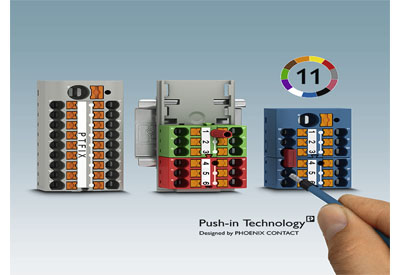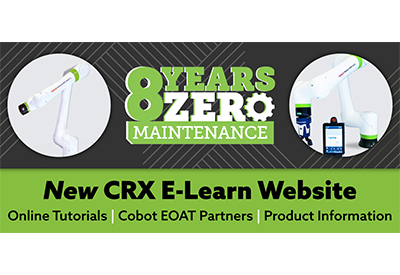Potential Distribution with Push-in Connection: Space-saving and time-saving supply and distribution


As automation becomes increasingly common, the number of sensors and actuators is also increasing – making potential distribution or collection more complex as a result. Assembly times can now be shortened considerably, thanks to the new concept of the PTFIX compact distribution blocks with push-in technology. Available in different numbers of positions and mounting types, the distribution blocks can be used straight away and extended as required.
Providing electrical energy and distributing it to consumers – this is the basic requirement for the electrical connection technology. What started with setting up electrical power grids for lighting systems and smaller electrical drives from the beginning of the 19th century, today is also a central topic for highly complex switch and controller systems. The connection technology was simple at that time – contacts were soldered or had screwed connections. Industrialization then caused a rapid evolution of the power grids with new possibilities for the distribution of electricity. The electrical connection technology has developed into the modular control cabinet wiring prevailing in industrial systems today. Electrical energy is no longer “just” distributed, it is also switched, controlled, converted and protected.
Triumphant march of the terminal block
Thanks to this evolution of the electrical connection technology, control cabinet and terminal box systems installed today can be much smaller and more modular. Flexibility, modularity and low space requirements are the main requirements for wiring components in industrial use. Increasingly optimized connection technologies – for example the direct plug-in spring technology – saves a lot of time while providing a high degree of electrical protection. Space requirements always play a large role because every centimeter in the control cabinet or in the connection box is a cost factor. In elevator manufacturing, machine building or building installations, the space for conventional components is often not available at all.
Moreover, in building installations, the components of the electrical connection technology must be specially qualified. For example, the insulation resistance for connector elements is determined by measurement in accordance with EN 60998-1 (connection material for low voltage electrical circuits for households and similar purposes). In addition, the tumbling barrel test in accordance with IEC 60068-2-32 is part of the standard-checking repertoire – it certifies that the test objects have a high mechanical robustness.
The specific size and function requirements of special applications can now also be satisfied by modern terminal blocks. Phoenix Contact provides the worldwide largest product range of mini- and micro-terminal blocks with a large multi-functional accessory system. Even for the smallest terminal blocks with their ingenious accessories and their easy installation, the user still needs time for installing the DIN rail or for connecting the terminal blocks.
Potential distributor blocks save space and effort required for making configurations
Because at least every second terminal block is bridged, even pluggable bridging solutions require a considerable amount of time for configuring the terminal strip. Moreover, the number of configured connections underlines the important role that the potential distribution plays in the connection technology. Phoenix Contact is therefore introducing a new product range at the Hannover Messe in 2017 that simplifies the distribution of electrical energy significantly. The PTFIX product range is not associated with the terminal blocks, but rather with the category of distribution blocks, as it is significantly different to the standard modular terminal block system. The distribution blocks are available in three variants with six, 12 and 18 connections each connected internally. The nominal cross sections are between 1.5 mm² and 2.5 mm², additional placing of bridges is unnecessary. The bridges with 2.5 mm² taps are also available as a variant with a power supply connection – a so-called feed-in contact. It has the same height as the 2.5 mm² tap, which itself is already quite small.
One of the biggest advantages of PTFIX lies in the fact that all connections in the now well-established push-in technology are available. The products can therefore be wired directly and quickly without tools – for solid and stranded conductors with ferrule from as small as 0.34 mm². The compact blocks of the product range PTFIX can be wired directly – right out of the box. This allows you to set up the electrical voltage distribution in a matter of seconds.
There are different solutions for attaching the distribution blocks in the particular application and these include preconfigured mounting feet for DIN rail TH 15 and TH 35. The large rail can be mounted horizontally and vertically. The mounting feet can be easily and flexibly pushed on the specially structured bottom area of the PTFIX blocks where they lock in various ways. This allows the user to install their system exactly as they like. The options for mechanically connecting the blocks to each other in a lengthwise direction is also helpful – robust “dovetailing” is not detachable. In addition, a snap-on foot does not have to be attached to every block but only every second one. This connection is helpful even when surface mounting is done with a flange. If both nominal cross sections have a flange, then this is alignable side by side for the 2.5 mm² blocks even on both sides.
High flexibility thanks to bonding
In addition to attaching PTFIX to the DIN rail and to the surface using a flange, it can also be secured with adhesive. The adhesive adapts to the bonding surface well and adheres immediately. This also helps the user to save much time and gain additional flexibility. If a control cabinet or terminal box is to be expanded, you do not have to search for a space for the DIN rail – PTFIX is simply bonded to the wall when wiring.
The marking can be made in the middle of the block using self-adhesive strips. For this, there is material off the roll that can be printed on a small local printer or obtained in marked strips that are ready for use. As a special feature, the self-contained PTFIX blocks can be connected using the standard reducing bridges with the well-established terminal block system Clipline complete. Feeding-in even larger cross-sections as well as protection with upstream fuse terminal blocks is easy.
Watch Phoenix Contact’s Ready-to-connect distribution blocks video HERE
















